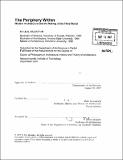The periphery within : modern architecture and the making of the Third World
Author(s)
Muzaffar, M. Ijlal (Muhammad Ijlal)
DownloadFull printable version (33.95Mb)
Alternative title
Modern architecture and the making of the Third World
Other Contributors
Massachusetts Institute of Technology. Dept. of Architecture.
Advisor
Mark Jarzombek.
Terms of use
Metadata
Show full item recordAbstract
This dissertation examines the critical role played by modern architecture and planning in shaping the discourse on Third World development after the Second World War. At stake here is an ignored dimension of the history of modern architecture and planning as well as that of the development discourse that sheds important light on the relationship of both these discourses to the trajectories of global domination and control. Critiques of development have largely focused on how the economic approaches proposed by international institutions such as the World Bank and the UN have favored the financial and political agendas of global industrial powers. This dissertation argues that design practices like architecture and planning-usually thought to be concerned only with shaping the physical environment-have also played a significant role in shaping the key assumptions of the development discourse, from the existence of urbanizing masses caught between demands of tradition and modernization to the exploding Third World city that is unable to manage its emergence into modernity. After the Second World War, as modern architecture began to lose its disciplinary footings as a medium of social reform in the industrialized world, modem architects and planners found tremendous opportunities as "experts" in programs of Third World development. The United Nations Housing Town and Country Planning section (HTCP), headed by Ernest Weissmann, a member of Congrns International d'Architecture Moderne (CIAM), sent out hundreds of missions, featuring famous housing and planning names such as Charles Abrams, Otto Koenigsberger, Catherine Bauer, and Jacob Crane, among others. (cont.) These missions produced master plans for cities from Singapore (recounted most famously by Rem Koolhaas in SMLXL) to Kabul to Beirut to Lima to Lagos, organized numerous conferences, and set up planning and public administration bodies, building research centers, and schools of architecture all over the decolonizing world. This dissertation examines this wide range of activity to identify particular modes of social and economic intervention, such as self-help architecture, "core" housing, and regional planning, that were able to negotiate the demands of postcolonial nation-states, the Cold War geo-political context, and the agendas of institutions of international finance emerging after the war.
Description
Thesis (Ph. D.)--Massachusetts Institute of Technology, Dept. of Architecture, 2007. Includes bibliographical references (p. 339-353).
Date issued
2007Department
Massachusetts Institute of Technology. Department of ArchitecturePublisher
Massachusetts Institute of Technology
Keywords
Architecture.